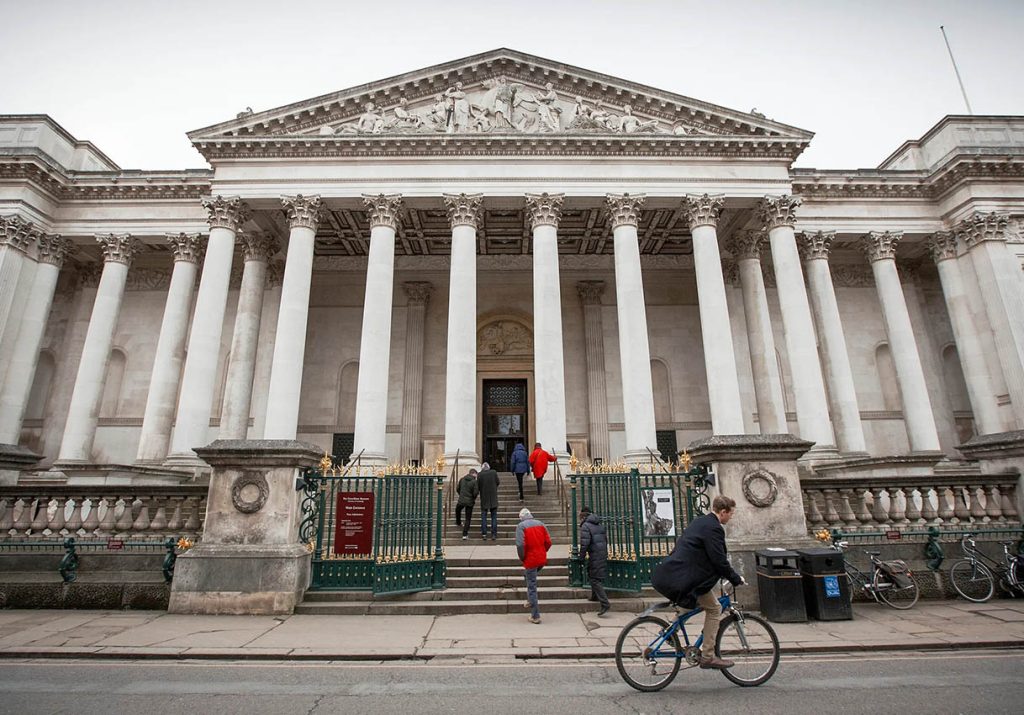Embarking on a voyage to the historic city of Cambridge, renowned for its architectural marvels, has been nothing short of a captivating adventure.
Explored Landmarks:
King’s College Chapel: A Gothic Masterpiece
Nestled in the very heart of Cambridge, the imposing silhouette of King’s College Chapel rises majestically, serving as an eloquent testament to the grandeur of Gothic architecture. My visit to this iconic structure transcended the realms of mere sightseeing, leaving an indelible mark on the canvas of my architectural appreciation.
As I stood in awe beneath the soaring spires, the intricate fan vaulting overhead captured my attention, showcasing a level of craftsmanship that attested to the mastery of medieval artisans. Each delicate curve and meticulously crafted detail in the chapel’s design spoke volumes about the dedication and skill invested in its creation. The stunning stained glass windows, with their kaleidoscopic array of colors, added another layer of enchantment to the architectural narrative, casting vibrant hues across the interior and creating an ethereal atmosphere.
The very essence of medieval craftsmanship echoed through every nook and cranny of the chapel, from the meticulously carved stone tracery to the soaring arches that seemed to reach towards the heavens. The imposing structure itself, with its intricate details and imposing presence, stood as a living embodiment of a bygone era, where artisans translated divine inspiration into tangible, awe-inspiring form.
Delving into the chapel’s rich 15th-century history only deepened the fascination. The centuries-old stories embedded within its walls seemed to come alive, intertwining with the architectural brilliance that has withstood the test of time. It was as if the chapel whispered tales of royal ceremonies, academic traditions, and the echoes of countless prayers that had reverberated within its sacred walls.
For a more immersive understanding, I opted for one of the guided tours, which proved to be an invaluable addition to the experience. Led by knowledgeable guides, these tours provided a captivating journey through the chapel’s storied past, unraveling its secrets and shedding light on the nuanced architectural nuances that might have otherwise gone unnoticed.
The guides skillfully wove historical anecdotes into the intricate details of the chapel’s structure, enriching my understanding of its significance. They pointed out the symbolism behind each element, from the meticulously crafted gargoyles that adorned the exterior to the symbolic representations within the stained glass panels. It was through these guided explorations that I gained a profound appreciation for the meticulous planning and spiritual symbolism imbued in every facet of King’s College Chapel.
King’s College Chapel is not merely a structure; it is a living testament to the convergence of history, artistry, and spiritual devotion. Its soaring spires and intricate details bear witness to the craftsmanship of yesteryears, while guided tours serve as windows into the rich tapestry of its past. This architectural marvel has left an indelible impression on my soul, shaping my architectural appreciation and kindling a newfound reverence for the timeless beauty encapsulated within its hallowed walls.
Pros:
The ethereal beauty of the chapel’s interior and surrounding courtyards is a visual feast for art and history enthusiasts.
Cons:
During peak tourist seasons, the chapel can get crowded, potentially affecting the tranquility of the visit.
Geographical Location:
Centrally located within the University of Cambridge campus, King’s College Chapel is easily accessible from various points in the city.
Access Route:
Walking is the most convenient mode of transportation within Cambridge, and the chapel is within a leisurely stroll from the city center.
Discounts and Booking:
Discounted tickets for students and group rates are available. Booking online through the official website ensures a smoother entry process.
The play of sunlight through the stained glass created a kaleidoscope of colors, turning my visit into a spiritual and architectural journey.
Fitzwilliam Museum: Art and Elegance
The Fitzwilliam Museum stands as a cultural gem in Cambridge, housing an extensive collection of art and antiquities. My exploration of this treasure trove was an enriching experience.
The museum’s architecture seamlessly blends classical and modern elements. The diverse exhibits cater to a wide range of interests, spanning from ancient civilizations to contemporary art.
Guided tours, educational programs, and interactive exhibits enhance the visitor’s understanding of the displayed artworks.

Pros:
The vastness of the collection ensures there’s something for everyone, from art aficionados to history buffs.
Cons:
Limited seating areas within the museum may pose a challenge for those looking to spend extended hours exploring.
Geographical Location:
Situated near the city center, the Fitzwilliam Museum is easily reachable by foot or public transport.
Access Route:
Walking from the central areas of Cambridge is recommended, allowing visitors to soak in the city’s charm along the way.
Discounts and Booking:
Entry to the museum is free, although donations are encouraged. Booking online facilitates a smoother entry process, especially during peak hours.
The diverse collection, ranging from Egyptian artifacts to modern paintings, provided a comprehensive journey through time. The museum’s ambiance fosters a sense of quiet contemplation, making it an ideal retreat for art enthusiasts.
Bridge of Sighs: A Romantic Canal Crossing
The Bridge of Sighs, an architectural gem spanning the River Cam, offers a romantic perspective of Cambridge. My punt ride under this bridge provided a unique view of the city’s architectural beauty.
Designed in the 19th century, the bridge’s neo-Gothic and Tudor architectural styles add to its allure. The covered passage between parts of St John’s College enhances its functionality.
Punting tours along the River Cam pass under the Bridge of Sighs, allowing visitors to appreciate its architectural details from the water.
Pros:
The romantic ambiance, especially during sunset, creates a picturesque setting for couples or those seeking a tranquil escape.
Cons:
Heavy tourist traffic along the river can lead to congestion during peak hours.
Geographical Location:
Centrally located, connecting two parts of St John’s College, the Bridge of Sighs is easily accessible along the River Cam.
Access Route:
Accessible by foot or punt, the bridge is conveniently positioned for those exploring Cambridge on foot or by water.
Discounts and Booking:
Punting tours can be booked at various locations along the River Cam. Discounts may be available for group bookings or online reservations.
The punt ride under the Bridge of Sighs offered a romantic and serene experience. The architectural details, coupled with the reflections on the water, created a timeless moment that encapsulated the essence of Cambridge.
Recommended Landmarks:
The Mathematical Bridge: Ingenious Engineering
The Mathematical Bridge, spanning the River Cam at Queens’ College, showcases a fascinating design that has intrigued mathematicians and engineers for centuries.
Built in the 18th century, the bridge’s design creates an optical illusion, giving the impression of a continuous curve despite being made entirely of straight timbers.
Visitors can enjoy views of the Mathematical Bridge while strolling through the college grounds. Some guided tours include insights into the bridge’s mathematical principles.
Pros:
The bridge’s unique design and its role in mathematical history make it a must-see for architecture and science enthusiasts.

Cons:
Limited public access to certain areas of Queens’ College may restrict the viewpoint for some visitors.
Geographical Location:
Situated within the Queens’ College grounds, the Mathematical Bridge is accessible from the city center.
Access Route:
Walking or cycling from the city center is recommended. Queens’ College may have specific entry points for visitors.
Discounts and Booking:
While entry to the college grounds may be free, access to certain areas or guided tours may have associated fees. Checking the college website for visitor information is advisable.
The Mathematical Bridge offers a captivating blend of art and mathematics, making it a hidden gem for those intrigued by the intersection of these disciplines.
The Round Church: A Historical Haven
The Round Church, officially known as the Church of the Holy Sepulchre, is one of Cambridge’s oldest and most unique architectural marvels.
Built in the 12th century, the church’s circular design is reminiscent of Jerusalem’s Church of the Holy Sepulchre. Its historical significance and architectural distinctiveness make it a compelling visit.
The church is open to the public, offering a peaceful retreat for those interested in its historical and architectural aspects.
Pros:
The Round Church’s historical charm and architectural rarity set it apart from other Cambridge landmarks.
Cons:
Due to its historical nature, accessibility for individuals with mobility challenges may be limited.
Geographical Location:
Centrally located, the Round Church is easily reachable from various points in Cambridge.
Access Route:
Walking is the most convenient mode of transportation within Cambridge, and the Round Church is within walking distance from the city center.
Discounts and Booking:
Entry to
the Round Church may be free, but donations are appreciated to support its preservation. Checking the church’s website for visitor information is advisable.
The Round Church offers a serene escape into history, providing a unique perspective on Cambridge’s religious and architectural heritage.
Wren Library at Trinity College: Literary Elegance
The Wren Library, nestled within the grounds of Trinity College, stands as a testament to architectural elegance and literary richness.
Designed by Sir Christopher Wren in the 17th century, the library houses rare manuscripts, ancient books, and literary treasures, making it a haven for bibliophiles.
While access to the library’s reading rooms may be restricted, visitors can explore designated areas showcasing some of its notable collections.
Pros:
The combination of architectural beauty and literary significance makes the Wren Library a captivating destination for intellectuals and book lovers.
Cons:
Access to certain areas may be limited, and photography restrictions may apply.
Geographical Location:
Situated within Trinity College, the Wren Library is centrally located in Cambridge.
Access Route:
Walking from the city center is convenient, and Trinity College may have specific entry points for visitors.
Discounts and Booking:
While access to some areas may be free, special exhibitions or guided tours may have associated fees. Checking Trinity College’s website for visitor information is advisable.
The Wren Library is a literary haven, where the beauty of architecture converges with the richness of written knowledge, creating an experience that transcends time.
Cambridge, with its architectural wonders, has been an enriching destination for an avid traveler like myself. From the grandeur of King’s College Chapel to the mathematical intrigue of the Bridge of Sighs, each landmark tells a unique story, blending history, art, and science into a harmonious narrative. As I continue to explore the world’s architectural wonders, Cambridge has undoubtedly etched itself as a city where the past meets the present in a breathtaking display of ingenuity and beauty.




